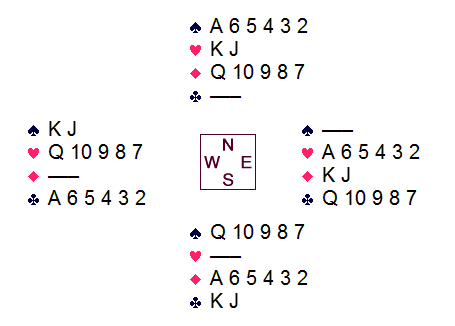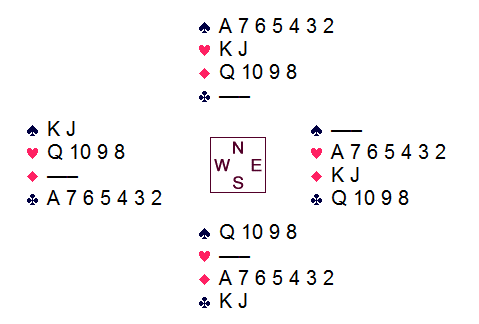

 |
 |
The Most Unique Bridge Hand of Them All
Since you never would encounter today's featured hand at the table, it doesn't particularly relate to the local club; but I would share it with you anyway.
Let's work up to the main event in three stages. Here is a deal in which
any declarer can make 1NT against best defense!

For example, on a club lead from west, dummy discards a diamond or a spade;
declarer then plays on spades. In the course of time, the defense will be
forced to give declarer a trick in hearts as well as clubs, enabling him to take
four spades and one trick in each other suit. The scenario is essentially
the same on a heart lead; the offense wins the race. Whoever has the opening
lead is forced to hand the opponents a trick in one of the K-J
combinations immediately, then in the other one later.

Now let's morph the hand somewhat, by swapping all the seven-spots
across the table:

This time, the tables are turned, because 1NT by any declarer
can be defeated. Possession of a fourth card opposite the long suits enables
the defenders to unscramble their tricks first. West can lead any card other
than a black-suit honor — say a low club. Declarer wins,
then plays on spades. Upon winning the second spade lead, west has the luxury
of returning any card in her hand. As declarer cannot access the long spades,
he winds up a trick short.

Let's try one further adjustment. Now the partners will swap
their eight-spots, whereupon a magical transformation takes place:

In this layout, 3NT by any declarer is unbeatable!
With south declaring against a club lead, a diamond is discarded from dummy. Declarer wins the first trick, then leads a low diamond. East takes that and returns a club; if it is ducked by west, then south cashes seven more diamonds and a spade for for ten tricks. So west takes his ace and returns a club to partner's ten. East can do no better than to cash the heart ace, for the offense has nine tricks established in the form of one club, seven diamonds, and the ace of spades.
Starting with the club ace is no better, as that suit still will be blocked. On an original heart lead, declarer pitches a spade from hand, then goes after that suit. The rest is essentially the same.
Should west try the tricky opening lead of a spade, declarer has options. If the king is led, declarer can even choose whether to win the first trick! There is no way that the defense can negotiate more than one trick in each suit.
The key to success is the shortage opposite the long suit, enabling an unblock,
plus the extra long-card winner. It appears that there is a 5-trick
penalty for being on opening lead, which could be the record. Talk about being
endplayed at trick one!
Note: This particular deal was first published by John Beasley in 1988, in his online Games & Puzzles Journal. Some years later another magazine printed the hand, alleging a "new computer discovery"; but that outfit recanted when the error was brought to its attention.

So is that the end of it? Or are there numerous other hands that
can produce nine tricks for everyone? At least regarding these mirror-type
layouts, the answer is no. A couple of programmers state their beliefs online
that there is no other such setup; but they also admit to some uncertainty on the
grounds that their research is incomplete. Well, my study is complete,
and I'm willing to stick my neck out and take my computer's word for it: This
is the only possible mirror-hand configuration wherein all declarers
can fulfill matching contracts other than 1NT.
It seems that our Wonder Hand occupies an exalted level,
far above the relatively mundane plethora of deals in which everyone takes
seven tricks or fewer. That qualifies it as unique indeed!
(Note: Subsequent research has generated several deals in which every declarer
can make a 1-level contract in the same suit; but those are not
mirror-style hands.)

DISCLAIMER: Just after uploading this article, my September issue of The Bridge World arrived; to my amazement, our special hand is featured in the Puzzle Corner! Kudos are in order for their interest in the deal; but for the record, the publication timing with this article was a pure coincidence. My own computer program generated this hand some time ago.